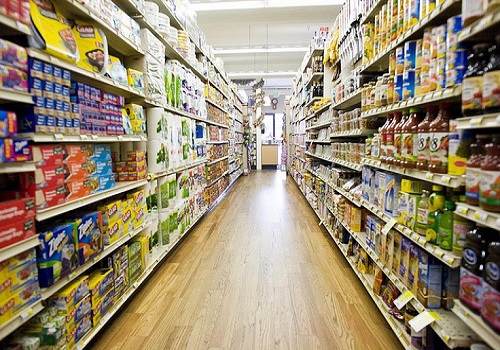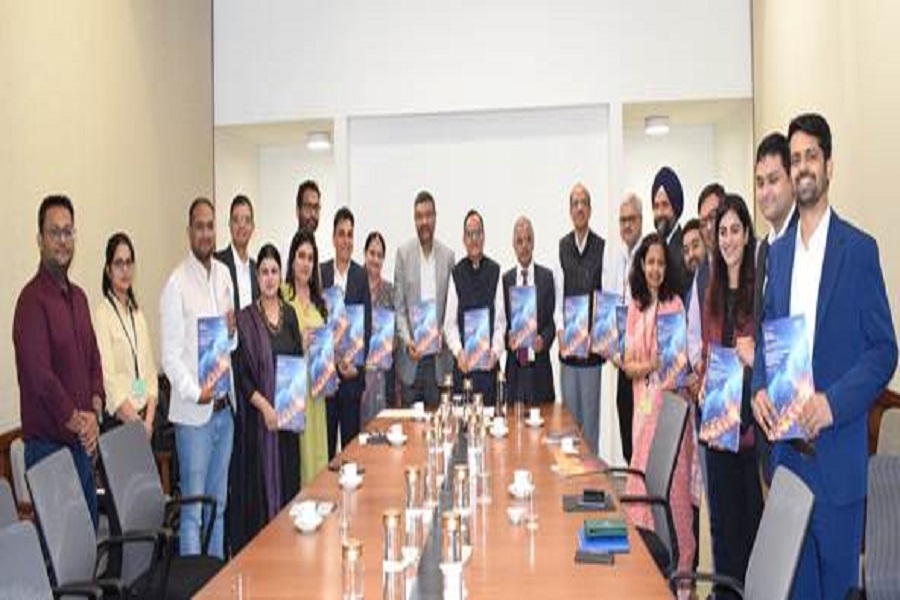INDIA INC ON CALL: Domestic cyclicals ignite resilience; OMCs temper corporate earnings by Motilal Oswal Financial Services Ltd

* In this report, we present the detailed takeaways from our 1QFY25 conference calls with various company managements as we refine the essence of India Inc.'s 'VOICES'.
* OMCs temper corporate earnings: The 1QFY25 corporate earnings came in line, with overall growth primarily being propelled once again by domestic cyclicals. Notable contributions were observed from the Healthcare, Real Estate, Capital Goods, and Metals sectors. In contrast, earnings growth was adversely affected by OMCs.
* For Banks, 1Q has been a seasonally slow quarter, and most of the banks have reported slower deposit growth too in 1QFY25. We cut our growth estimates for many of the banks amid slower deposit growth and a higher C/D ratio across several banks and the system. Most of the banks have raised their deposit rates in 1QFY25 amid rising competition in deposits. Banks are still increasingly relying on the bulk TDs and CDs to fund their asset growth.
* Within NBFC/HFC, various management teams highlighted the following: 1) disbursements in the mortgage segment were hit by the RBI Fair Practices Code circular in addition to 1Q being the seasonally weakest quarter; 2) asset quality deteriorated across most product segments because of elections, heat waves, higher attrition rates, and even the impact on customers' earnings; 3) the MFI segment, in particular, is experiencing lower collections and slippages into forward buckets due to customer over-leveraging, 4) borrowing costs largely peaked out and everyone is looking forward to repo rate cuts; and 5) competitive intensity in gold loans, from both Banks and NBFCs, moderated.
* Most of the management teams in the Automobile have noted that a normal monsoon and the upcoming festival season are expected to boost auto volume growth following a subdued first quarter. The 2W segment is anticipated to outperform other segments. Most of the ancillary companies with overseas exposure have reported a weak demand environment for autos, though there are signs of improvement in the non-auto sector. Ancillaries that have outpaced industry growth have largely done so through increased content and new order wins. However, due to cost inflation, some companies expect a decline in gross margins in the coming quarters.
* In Healthcare, companies indicated sustained growth momentum in the chronic category of therapies in the DF segment for the quarter. The weak seasonality hit the off-take of products in acute therapies as per the management teams. Interestingly, raw material costs are likely to sustain at lower levels over the near-to-medium term and drive better gross margins for companies having exposure to the branded domestic formulation segment.
* The management teams of various IT companies continue to exercise caution regarding the near-term demand outlook, as the demand from discretionary projects remains unchanged compared to previous quarters; however, BFSI clients in the US experienced a slight recovery in discretionary spending in 1Q. Clients' focus is now slightly shifting away from cost-takeout deals to "high-priority" transformation deals in some pockets.
* In the ferrous Metals space, management teams across companies pointed to: 1) stable to declining coking coal costs; and 2) the development of captive raw material mines. Though a better performance from Indian operations backed by strong domestic demand should aid volumes and margins in the near term, management teams believe that global uncertainties might pose challenges to international steel, base metal, and raw material prices in the short term. In the non-ferrous space, management teams guided the CoP to decline, leading to margin accretion in FY25.
* Consumer companies have experienced a sequential improvement in demand, with signs of revival in the rural market due to price cuts and enhanced consumer offerings. However, harsh summer conditions and election-related restrictions have impacted consumption in categories such as home insecticides, beverages, alcoholic beverages, and paints. Management anticipates implementing price increases in the 2HFY25 to offset rising raw material costs and drive revenue growth.
Autos
* Management teams have noted that a normal monsoon and the upcoming festival season are expected to boost auto volume growth following a subdued first quarter. The 2W segment is anticipated to outperform other segments. Most of the ancillary companies with overseas exposure have reported a weak demand environment for autos, though there are signs of improvement in the non-auto sector. Ancillaries that have outpaced industry growth have largely done so through increased content and new order wins. However, due to cost inflation, some companies expect a decline in gross margins in the coming quarters.
Capital Goods
* Companies continue to witness strong traction from sectors such as power T&D, renewable energy, data centers, real estate, and defense. International geographies are a mixed bag with robust traction in the Middle East and Africa being offset by muted conditions in developed countries, owing to geopolitical tensions, elevated interest rates, and a subdued macroeconomic scenario. Margin performance for EPC players is expected to see an uptick from 2HFY25 as newer orders booked at favorable prices come up for execution and input costs remain benign. Order inflow too is expected to ramp up with the elections and budget behind us. The domestic enquiry pipeline is shaping up well and is expected to translate into firm orders. Availability of labor is a key monitorable going forward, as EPC players reported lower-than-expected domestic execution owing to the shortage of skilled and semi-skilled labor.
Cement
* Several cement companies are witnessing consolidation, which will intensify the industry, and this should benefit in the longer term. Cement demand is expected to improve in 2HFY25, backed by infrastructure and housing segments. Cement demand is estimated to grow between 6-7% YoY in FY25, considering muted growth in 1HFY25. Cement prices have further declined ~1-2% in Jul’24 vs. avg. of 1QFY25 and are likely to remain soft till CY24-end.
Chemicals Specialty
* Various management teams mentioned that while destocking is over for most of the companies, pricing pressure persists in the sector. Companies highlighted that they expect 2HFY25 to be better than 1HFY25. They also emphasized that the lead time has increased, which is taking longer than expected for the FG to be delivered to customers and RM to reach the plants of the companies as well. This has been creating some pressure on the margin as RM prices, freight, and container rates have also increased.
Consumer
- The consumer companies have experienced a sequential improvement in demand, with signs of recovery in the rural market due to price cuts and enhanced consumer offerings. However, harsh summer conditions and election-related restrictions have hurt consumption in categories such as home insecticides, beverages, alcoholic beverages, and paints. Management anticipates implementing price increases in the 2HFY25 to offset rising raw material costs and drive revenue growth. The outlook for rural markets remains positive. EBITDA margins are expected to improve at a moderate pace over the medium term, supported by operating leverage, a better product mix, and growth in the premium portfolio.
Financials
Banks
* The first quarter has seen a seasonally slow quarter, and most of the banks have reported slower deposit growth too in 1QFY25. We cut our growth estimates for several banks amid slower deposit growth and a higher C/D ratio across many banks and the system. Most of the banks have raised their deposit rate in 1Q, amid rising competition in deposits. Banks are still increasingly relying on the bulk TDs and CDs to fund their asset growth. The decline in industry-wide CASA mix led to higher funding costs. With rising costs, NIMs are likely to witness a mild moderation, albeit at a slower rate.
* PSU Banks have continued to report steady earnings led by improving asset quality. Opex growth normalized after elevated wage/pension provisions, which lasted until 4QFY24. The SMA pool continues to remain lower, while slippages from the restructured pool continue to remain lower. With healthy PCR and healthy contingency buffers, credit costs are expected to be lower, supporting earnings. Most of the banks have guided for lower credit costs amid healthy recoveries and contained slippages. While caution prevails on the potential increase in delinquencies for unsecured loans, it is anticipated that credit costs will remain under control in the coming quarters.
NBFC
* Within NBFC/HFC, various management teams highlighted the following: 1) disbursements in the mortgage segment were hit by the RBI Fair Practices Code circular in addition to 1Q being the seasonally weakest quarter; 2) asset quality deteriorated across most product segments because of elections, heat waves, higher attrition rates, and even the impact on customers’ earnings; 3) the MFI segment, in particular, is experiencing lower collections and slippages into forward buckets due to customer over-leveraging, 4) borrowing costs largely peaked out and everyone is looking forward to repo rate cuts; and 5) competitive intensity in gold loans, from both Banks and NBFCs, moderated. Difficulty in getting unsecured credit (either personal loans or MFI loans) could result in higher demand for gold loans.
Capital Markets
* The capital market was volatile in 1QFY25, with F&O and cash volumes reaching new highs; about 15.5m (as of Jul’24) demat accounts were added, and NSE active clients rose to 45.7m (Jul’24). Angel One saw strong revenue growth (+76% YoY), but operating margins were pressured by investments in customer acquisition, IPL advertisement costs, and new business expansion.
Insurance
* The general insurance players have seen decent growth in premiums driven by the strength of auto sales, sustained high demand for health insurance, and commercial lines growing in line with economic growth. Motor segment profitability improved, but health segment loss ratios remained elevated. Star Health's increased claims ratio pushed the combined ratio up by ~350bp above estimates. ICICIGI and STARHEAL saw a 16% YoY NEP growth each, with PAT up 49%/11%, respectively. Life insurers (excluding Max) reported healthy premium growth led by ULIPs. However, adverse product mix led to pressure on VNB margins. IPRU/SBILIFE/HDFCLIFE reported APE growth of 34%/20%/23% YoY, with VNB margins contracting 590bp/200bp/120bp YoY.
Healthcare
* In Healthcare, companies indicated sustained growth momentum in the chronic category of therapies in the DF segment for the quarter. The weak seasonality hit the off-take of products in acute therapies as per the management teams. Interestingly, raw material costs are likely to sustain at lower levels over the near-to-medium term and drive better gross margins for companies having exposure to the branded domestic formulation segment. For the US generics space, management indicated that while price erosion is limited on the base portfolio, the cost of logistics/supply chain has increased due to geopolitical turmoil. The filings are inclined towards complex products, and thus, there is a reduction in the overall pace of filings according to the management teams. On the hospital front, companies are implementing efforts towards adding beds and treating more number of in-patients as well as out-patients. Management indicated about some more scope of improving ARPOB based on the case mix/payor mix. Some companies indicated that they have scaled-up efforts towards increasing international patient flow considering the locational advantage and availability of strong clinical talent. Overall, the pharma space continues to witness tailwinds led by niche pipelines in the US and EU. Hospitals remain poised to benefit from the considerable demand-supply gap by not only adding infrastructure but also nurturing the doctor-nurse resources.
Logistics
* In the logistics sector, demand activity was subdued primarily due to general elections, high inflation impacting MSME customers, and e-commerce volumes during 1QFY25. E-commerce and express logistics companies continued to report sluggish growth during 1Q due to high competitive pressure. Multi-modal logistic companies performed better than pure-play freight operators and express logistics players. Management anticipates improved operational performance with the onset of festive season, particularly with reduced fuel charges and stable operating costs. In the long term, companies are optimistic about sector growth, driven by e-way bills, GST implementation, expanded routes on the Dedicated Freight Corridor (DFC), and enhanced connectivity of major ports, which are expected to encourage businesses to move towards the organized sector.
Metals
* In the ferrous Metals space, management teams across companies pointed to: 1) stable to declining coking coal costs; and 2) the development of captive raw material mines. Though a better performance from Indian operations backed by strong domestic demand should aid volumes and margins in the near term, management teams believe that global uncertainties might pose challenges to international steel, base metal, and raw material prices in the short term. In the non-ferrous space, management teams guided the CoP to decline, leading to margin accretion in FY25.
Oil & Gas
* Major OMC company’s expansion projects are set to wrap up in the next two years, setting the stage for substantial growth. CGDs are optimistic about robust volume growth and margins, given that spot LNG prices are anticipated to stay stable. ONGC and OINL also forecast strong production growth due to KG-98 and NRL, respectively. Additionally, gas utility entities are anticipating continued strong transmission volumes.
Real Estate
* The companies have identified a pipeline that can support their ambition of 20-30% growth in FY25, notwithstanding their high base. Companies exuded confidence in demand sustainability for a couple of years, and timely launches remain top priority given the minimal inventory level of most of the developers.
Retail
* Retail: Continued demand slowdown fueled by heatwaves, election headwinds has impacted footfalls/productivity in 1QFY25, and hence revenue remained subdued (largely negative to single-digit positive). Exceptions were Trent/V-Mart/DMart. Sector-wide management commentary indicated recovery from 2HFY25.
* QSR: The Quick Service Restaurant (QSR) industry continues to face demand challenges, grappling with weak unit economics and intense market competition. There has been some improvement in the delivery channel, driven by increased traffic, while dine-in demand is still weak. We remain cautious about the anticipated demand recovery in the 2HFY25. Margins have also been negatively affected. Despite these challenges, management is maintaining its guidance for store expansion in FY25.
Technology
* The management teams of various IT companies continue to exercise caution regarding the near-term demand outlook, as the demand from discretionary projects remains unchanged compared to previous quarters; however, BFSI clients in the US experienced a slight recovery in discretionary spending in 1Q. Clients’ focus is now slightly shifting away from cost-takeout deals to “high-priority” transformation deals in some pockets. Moreover, revenue growth, utilization, and pyramid optimization will be key drivers for margin improvement, providing some room for margin gains in FY25. The management teams suggest that FY25 should be better than FY24. The strong deal wins, along with early signs of recovery driven by BFSI, bode well for growth in FY25.
Telecom
* The Indian telecom sector registered revenue/EBITDA growth of 1.5%/1.8% QoQ in 1QFY25, led by a 0.7% increase in subscribers (7.7m net adds QoQ). ARPU was flat. The market share shift continues, with RJio/BHARTI gaining subscribers. Management indicated that from 2QFY25 onwards, the tariff hike (of 15-20%) should translate into the revenue increase (by 11%-13% in the next 2-3 quarters). Companies remain focused on deleveraging their balance sheets. Capex is expected to moderate in FY25 for BHARTI/RJio, while VIL’s capex is likely to remain around INR500-550b over the three years to support network upgrade.
For More Motilal Oswal Securities Ltd Disclaimer http://www.motilaloswal.com/MOSLdisclaimer/disclaimer.html
SEBI Registration number is INH000000412






















